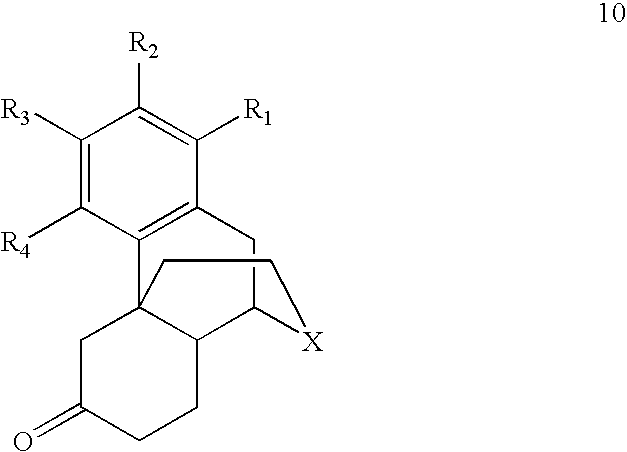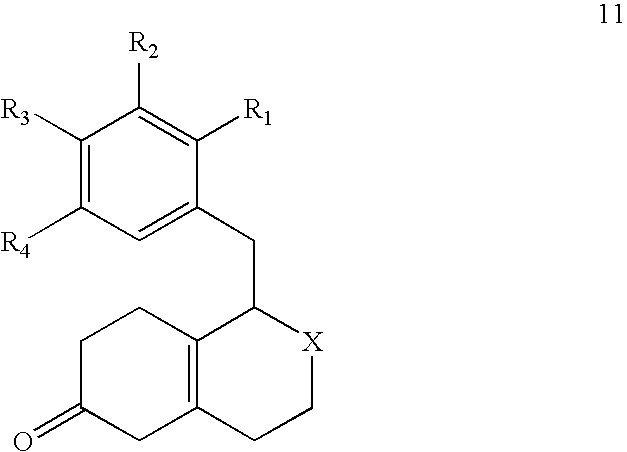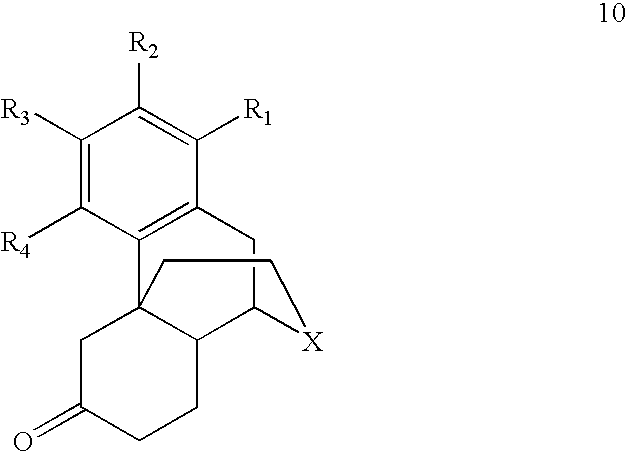Processes for Preparing Morphinans and Intermediates Thereof
a technology of morphinan and intermediates, which is applied in the field of synthesis of morphinan, can solve the problems of low yield of desired cyclized product, difficult crystallization of ,-hexahydroisoquinolinone, and reproducibility problems
- Summary
- Abstract
- Description
- Claims
- Application Information
AI Technical Summary
Benefits of technology
Problems solved by technology
Method used
Image
Examples
example 1
Conversion of α,β-hexahydroisoquinolinones to Protected β,γ-hexahydroisoquinolinone
[0192]
[0193]A solution of the isomers 1-(2′-bromo-4′-methoxy-5′-hydroxybenzyl)-2-formyl-1,3,4,7,8-hexahydroisoquinolin-6-one and 1-(2′-bromo-4′-methoxy-5′-hydroxybenzyl)-2-formyl-1,3,4,5-hexahydroisoquinolin-6-one in chloroform solvent was added to ethylene glycol (e.g., ketone protecting compound) over 1 hour to form a solution of 1-(2′-bromo-4′-methoxy-5′-hydroxybenzyl)-2-formyl-6-ketal-1,3,4,5,7,8-hexahydroisoquinoline (>90% area / area by HPLC analysis).The solution was added to 5% NH4OH (200 mL) to form a suspension that was extracted with chloroform (3×40 mL). The combined organic layers were washed with water (3×100 mL) and placed under vacuum until dry to give the product as a white solid (1.03 g, 80% area / area and 70% w / w / by HPLC assay).
example 2
Hydrolysis of protected β,γ-hexahydroisoquinolinone to Unprotected β,γ-hexahydroisoquinolinone
[0194]
[0195]A sample of 1-(2′-bromo-4′-methoxy-5′-hydroxybenzyl)-2-formyl-6-ketal-1,3,4,5,7,8-hexahydroisoquinoline (0.97 g) was dissolved in 10 mL of 88% acetic acid. The resultant solution was stirred for 1 hour at room temperature. After the solution had been stirred for 1 hour, the solution was diluted with 50 mL of H2O and 40 mL of chloroform, swirled, and then poured into a 500 mL separatory funnel. The mixture was mixed and vented and the organic layer was separated. Another 40 mL of chloroform was added to the aqueous layer. The solution was repeatedly mixed and vented and the organic layer was once again separated leaving the aqueous layer in the separatory funnel. Once again 40 mL of chloroform was added to the aqueous layer. The solution was swirled again and the organic layer was once again separated leaving the aqueous layer in the separatory funnel. The organic layer was washe...
example 3
Grewe Cyclization Step
[0196]
[0197]A mixture of 270 mL of 98% trifluoromethane sulfonic acid and 60 mL 99% trifluoromethanesulfonic anhydride was added to a 2 L round bottom flask. The mixture was heated to reflux and the vapor temperature reached to between 88° C. to 130° C. The solution was cooled to between 5° C. to 10° C. under N2. A solution of 100 g 1-(2′-bromo-4′-methoxy-5′-hydroxybenzyl)-2-formyl-1,3,4,5,7,8-hexahydroisoquinolin-6-one (e.g., β,γ-hexahydroisoquinolinone) dissolved in 750 mL of CHCl3 was placed in a 1 L round bottom flask and was put under nitrogen. The β,γ-hexahydroisoquinolinone solution was added to the trifluoromethanesulfonic acid solution at a constant rate over a period of 30 minutes and constantly stirred. The trifluoromethanesulfonic acid solution was surrounded by an ice bath in order to keep the temperature of the solution under 15° C. during the addition of the β,γ-hexahydroisoquinolinone. After the combination of the solutions was complete, the rea...
PUM
 Login to View More
Login to View More Abstract
Description
Claims
Application Information
 Login to View More
Login to View More - R&D
- Intellectual Property
- Life Sciences
- Materials
- Tech Scout
- Unparalleled Data Quality
- Higher Quality Content
- 60% Fewer Hallucinations
Browse by: Latest US Patents, China's latest patents, Technical Efficacy Thesaurus, Application Domain, Technology Topic, Popular Technical Reports.
© 2025 PatSnap. All rights reserved.Legal|Privacy policy|Modern Slavery Act Transparency Statement|Sitemap|About US| Contact US: help@patsnap.com



